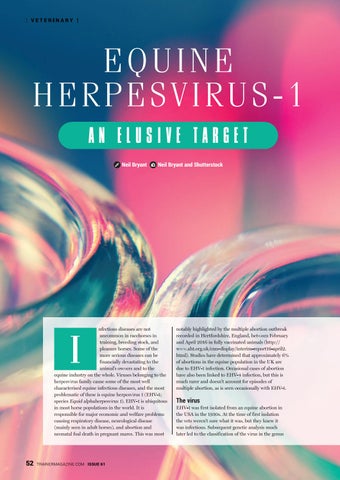| VETERINARY |
EQ UIN E HER PESV IR US- 1 AN ELUSIVE TARGET Neil Bryant
I
Neil Bryant and Shutterstock
nfectious diseases are not uncommon in racehorses in training, breeding stock, and pleasure horses. Some of the more serious diseases can be financially devastating to the fin fi animal’s owne ners and to the equine industry on the whole. Viruses belonging to the herpesvir irus family cause some of the most well characterised equine infectious diseases, and the most problematic of these is equine herpesvir irus 1 (EHV-1; species Equid alphaherpesviirrus 1). EHV-1 is ubiquitous in most horse populations in the world. It is responsible for major economic and welfare problems causing respiratory disease, neurological disease (mainly seen in adult horses), and abortion and neonatal foal death in pregnant mares. This was most
52
TRAINERMAGAZINE.COM ISSUE 61
notably highlighted by the multiple abortion outbreak recorded in Hertfordshire, England, betwe ween February and April 2016 in fully vaccinated animals (htt ttp:// ttp www. www ww w.aht.org.u uk/cms-display/interim-report16-april2. html). Studies have determined that approximately 6% of abortions in the equine population in the UK are due to EHV-1 infection. Occasional cases of abortion have also been linked to EHV-4 infection, but this is much rarer and doesn’t account for episodes of multiple abortion, as is seen occasionally wit ith EHV-1.
The virus
EHV-1 was fi first isolated from an equine abortion in fir the USA in the 1930s. At the time of fi first isolation fir the vets weren’t sure what it was, but they knew it was infectious. Subsequent genetic analysis much later led to the classifi fication of the vi fic virus in the genus vir
